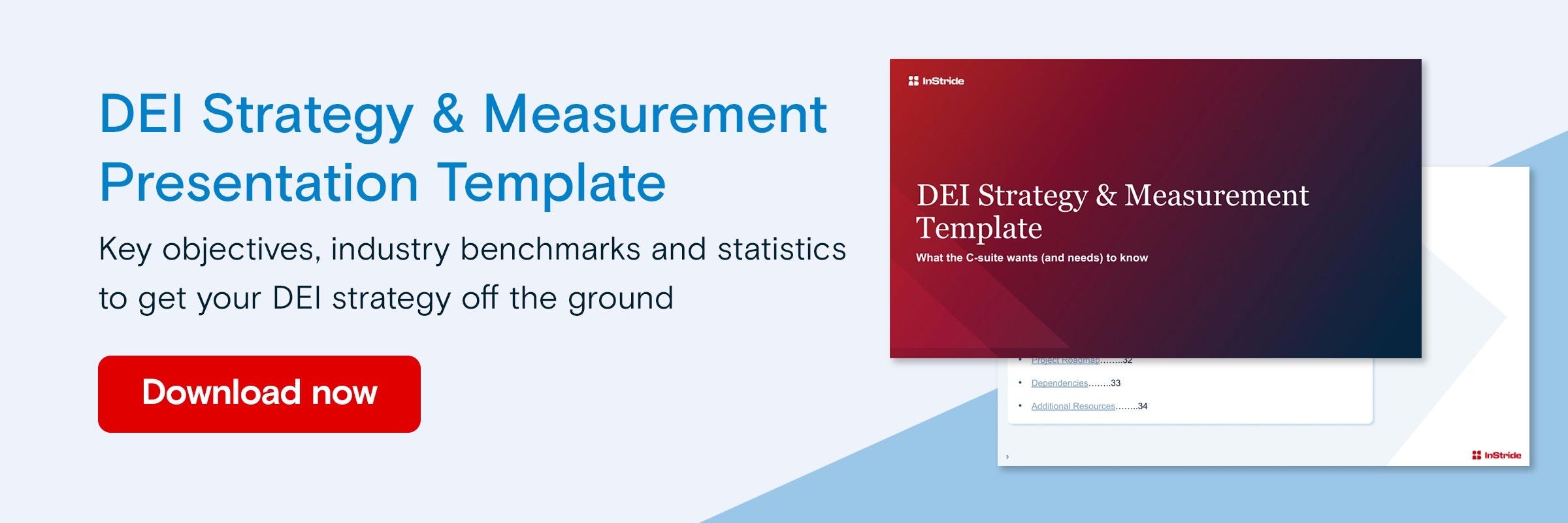Employee resource groups (ERGs) provide a framework for employees to come together over shared backgrounds or interests and amplify the voices of employees who may not feel heard. What originated as a way to promote diversity, equity and inclusion in the workplace, ERGs have expanded to encompass all varieties of shared experiences, including gender, sexual orientation, religion, age, parent status, nationality and other demographics or interests.
As of 2023, 90% of Fortune 500 companies have ERGs. With the proper guidance and oversight, employee resource groups can have a powerful impact on the employee experience, particularly when it comes to engagement, job satisfaction and belonging. These benefits can extend to other areas as well, helping to promote retention and support DEI goals.
Let's discuss how to make the most of your ERG strategy to drive impact for your business and workforce.
The business benefits of employee resource groups
The business impact of employee resource groups is far-reaching.
Employee resource groups offer a powerful avenue for employees to connect, access resources and engage in meaningful dialogues within a safe and judgment-free space. This helps to cultivate a more diverse, equitable, and inclusive work environment by nurturing a profound sense of community and belonging among all team members. These benefits can cascade to other areas, positively contributing to job satisfaction and even employee engagement and retention.
As ERGs have become more popular, both employees and job-seekers have started to view ERGs as an integral part of workplace culture. One survey revealed that 70% of Gen-Z employees are 70% more likely to apply for a company that had ERGs.
Beyond this, ERGs also serve as catalysts for learning, development, and innovation. These groups help to facilitate connections between employees of differing levels and job functions which opens up access to mentorship, networking and other professional development opportunities.
8 ways to maximize the impact of employee resource groups
Although it’s common for employee resource groups to form organically, this doesn’t mean you should adopt a “set it and forget it” strategy. To be effective, ERGs still require a certain level of oversight and guidance.
Take a look at these best practices to help guide your approach:
- Encourage ERGs to develop mission statements
A clear mission statement guides the purpose and direction of the ERG, as well as helps potential members identify whether a particular ERG is right for them. Some groups may come up with a mission statement on their own, while others may need a bit more guidance. Take care not to stifle employee-led initiatives. Instead, build on them. - Define leadership roles
As with any team, a strong ERG leader can make all the difference. Strategize how HR can best collaborate with ERGs to identify leaders willing to take on the day-to-day management of the groups. This can include everything from managing meeting agendas to facilitating discussions and planning events. Highlight this is an opportunity for employees to showcase leadership abilities and take on more responsibilities that fall outside of their roles. - Leverage ERGs to highlight employee opportunities
If you want to spread the word about relevant employee events, benefits, development opportunities or resources, ERGs should be one of your first stops. Use this as a channel to foster company culture and promote employee-centric initiatives. - Offer tailored opportunities for learning & development
Consider providing tailored learning and educational resources to members of an ERG based on the specific needs and desires of the group.
For example, individuals in leadership positions within ERGs might benefit from an information session that highlights the leadership training and education opportunities that your company currently offers. Or, in a group for single parents, you might discuss how your workforce education program allows for flexible learning that can fit even the busiest schedules. - Collaborate on aligning ERG goals to business objectives
Let’s be clear: ERGs do not exist to reach business objectives. To lead with that idea discounts its primary purpose of community, advocacy and growth. But it also does a disservice to the members when you don’t consider how ERGs are contributing to the greater business objectives.
Work with ERG leaders to establish group goals that support their mission statement, fulfill their purpose and have some alignment with the goals of the business. - Solicit executive sponsorship
Consider making it a standard practice for individual ERGs to receive investment and support from at least one company executive to create both better resourcing and open communication channels.
From a leadership perspective, collaborating with ERGs can provide insight into a particular population’s interests and concerns, as well as a diversity of ideas that can lead to new approaches for solving business challenges.
- Compensate ERG leadership for increased responsibilities
It’s common for organizations to request ERG leaders to assist with tasks that fall outside their scope of work, such as sitting in on an interview panel for a role that is outside of their team. If this is the case, ensure that they are being fairly compensated and/or rewarded for the additional work. - Establish active communication channels between HR and ERG leadership
It’s important that ERGs are not siloed off from the rest of the company. Strategize how HR can standardize communication channels between relevant staff and ERG leaders to ensure that all parties are on the same page and have the resources they need to be successful.
4 critical ERG metrics to measure
ERGs require an investment of time and money. To ensure support from executive leadership and to identify areas in which the company may be able to provide better support, consider tracking these four key metrics:
- Membership numbers and rates, including total number of members, length of member tenure and percentage of new members recruited per annum.
- Group participation in company events, as well as external involvement in local community events. This is to gauge whether or not the group is engaged with and impacting overall company culture.
- Member satisfaction and sentiment surrounding their ERG, including how they feel about participating on the ground and if their ERG is living up to its mission statement and goals.
- Representation and inclusivity within and among ERGs, including race, gender, and other demographic information.
- Career progression for ERG members, with comparisons between ERGs, as well as in contrast to non-ERG members or the entire organization.
Inspiring growth and belonging with employee resource groups
ERGs have brought change for 50+ years, and today’s modern ERGs have the capacity to do even more. By building a culture of community and belonging and supporting members’ growth, you can build a workforce invested in the success and greater good of your organization.
More talent and skills development resources: Unlock this comprehensive guide to skill-building for actionable tips on how to fast-track employee upskilling and reskilling within your organization.


